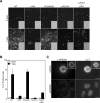A very late viral protein triggers the lytic release of SV40
- PMID: 17658947
- PMCID: PMC1924868
- DOI: 10.1371/journal.ppat.0030098
A very late viral protein triggers the lytic release of SV40
Abstract
How nonenveloped viruses such as simian virus 40 (SV40) trigger the lytic release of their progeny is poorly understood. Here, we demonstrate that SV40 expresses a novel later protein termed VP4 that triggers the timely lytic release of its progeny. Like VP3, VP4 synthesis initiates from a downstream AUG start codon within the VP2 transcript and localizes to the nucleus. However, VP4 expression occurs approximately 24 h later at a time that coincides with cell lysis, and it is not incorporated into mature virions. Mutation of the VP4 initiation codon from the SV40 genome delayed lysis by 2 d and reduced infectious particle release. Furthermore, the co-expression of VP4 and VP3, but not their individual expression, recapitulated cell lysis in bacteria. Thus, SV40 regulates its life cycle by the later temporal expression of VP4, which results in cell lysis and enables the 50-nm virus to exit the cell. This study also demonstrates how viruses can generate multiple proteins with diverse functions and localizations from a single reading frame.
Conflict of interest statement
Figures






References
-
- Mellman I, Warren G. The road taken: Past and future foundations of membrane traffic. Cell. 2000;100:99–112. - PubMed
-
- Smith AE, Helenius A. How viruses enter animal cells. Science. 2004;304:237–242. - PubMed
-
- Gruenberg J, van der Goot FG. Mechanisms of pathogen entry through the endosomal compartments. Nat Rev Mol Cell Biol. 2006;7:495–504. - PubMed
-
- Kirn D, Martuza RL, Zwiebel J. Replication-selective virotherapy for cancer: Biological principles, risk management and future directions. Nat Med. 2001;7:781–787. - PubMed
Publication types
MeSH terms
Substances
Associated data
- Actions
- Actions
- Actions
- Actions
- Actions
- Actions
- Actions
- Actions
- Actions
- Actions
- Actions
- Actions
- Actions
Grants and funding
LinkOut - more resources
Full Text Sources
Other Literature Sources

